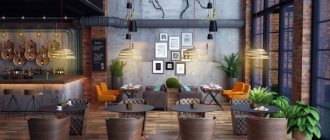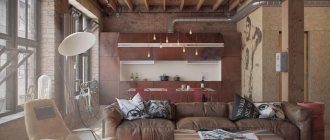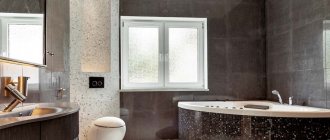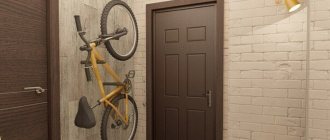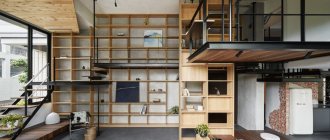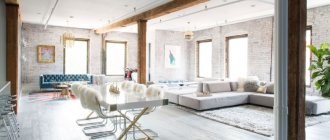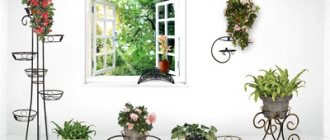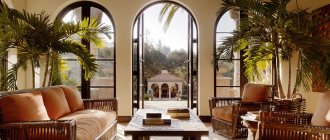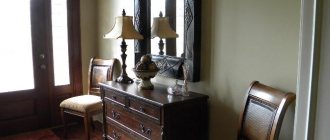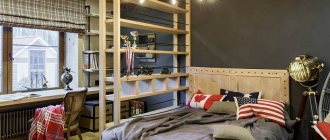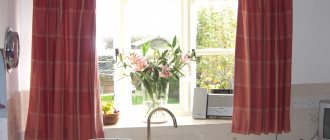Tile in the loft - the best solution for your budget and advice on choosing for the floor, bathroom and kitchen
ReLend.ru » Styles » Tiles in the loft - the optimal solution for your budget and advice on choosing for the floor, bathroom and kitchen
You are finishing a new apartment, or you have decided to radically change the style of your home. Perhaps the loft style (from the English loft - attic) will suit you. It actively uses tiles that imitate concrete, brick, asphalt and other materials typical for the interiors of attics, warehouses and industrial premises.
Contents of the article [hide show]
Reference . The style originated in America in the mid-20th century. If for Western countries it is quite familiar (although it does not lose its relevance), then in Russia it is only gaining popularity.
In the interior photos below, you can see how harmoniously the tiles fit into the loft style. As you can see, despite the apparent asceticism, rooms decorated within this style can be very beautiful and cozy.
Where and how to buy bathroom tiles in loft and industrial styles?
You can buy loft style tiles at any Santa Ceramics store in Moscow. We recommend that you first accurately measure the size of the bathroom and come to the store with all the data (including door openings, ceiling height, etc.).
Stores accept bank cards, cash and non-cash forms of payment. You can pay for your order as if it were a private order. and from a legal entity. In addition, you can pay for your order by card on this website. To do this, just call +, issue an invoice and leave a contact e-mail to receive a payment link.
Tile delivery is usually made within 2 business days from the date of payment, but you can pick up the goods yourself from the warehouse on the day of payment. All of our salons are ready to provide you with a free design project for a room to suit your dimensions, subject to the purchase of tiles from our range. Call +!
Floor
For the floor, materials that imitate concrete or metal are often chosen. An excellent choice is graphite tiles, which resemble asphalt in appearance. A universal solution for both walls and floors is tiles that look like aged brick. Currently, leading manufacturers of facing ceramics create them using casts from authentic ancient masonry. A wonderful option for the floor is an imitation of aged hexagonal brick.
Important ! Remember contrasts. If the floor is finished in brick, which is usually distinguished by rich, warm shades, then the walls can be decorated in cool, light colors like concrete or metal.
Industrial textures
For several years now, one of the main trends in ceramic tile design has been copying various textures. At first, imitations were limited to stone and wood; today you can also buy tiles with the texture of concrete, plaster, clay, and even metal.
Brick
Brick is perhaps one of the main attributes of the loft style. And if the room cannot boast of original brickwork, it can be successfully replaced by high-quality ceramic imitation.
In the photo: Cir & Serenissima Chicago tiles stylized as industrial brick.
In the photo: imitation aged brick in the Cir & Serenissima Havana collection.
Pictured: Fap Firenze Heritage porcelain tiles.
Concrete
Concrete-look tiles have been confidently holding their position on the market for three years. Its choice is huge: there are rectangular, square and hexagonal formats, relief “concrete tiles” and even mosaics stylized as concrete.
Concrete-effect tiles are an excellent neutral backdrop for bright furniture, accessories, paintings and posters. You can even put graffiti on it if you want something extraordinary.
In the photo: Apavisa Forma porcelain floor tiles specially designed for loft interiors.
In the photo: porcelain tiles with the texture of aged concrete La Fabbrica Lascaux.
In the photo: large format porcelain tiles Iris Solid Concrete.
Metal
A new texture that realistically copies porcelain stoneware - metal. In this category you can find tiles that look like aged copper, stamped steel sheets, cast iron, painted metal.
Tiles stylized as industrial metal are perfect for a truly masculine interior with a strong character. It can be combined with ceramics with the texture of concrete or brick, and can also be used as a background covering.
In the photo: metal-look porcelain tiles Iris Stage.
In the photo: large-format porcelain tiles Iris Metal XXL.
In the photo: Ergon Metal porcelain tiles. It.
Plaster
Popular today, textured tiles, stylized as decorative plaster, are an excellent option for background decoration of walls or floors in a loft.
You need to choose tiles with the texture of plaster in the salon. Photos do not convey her character. A tile that may seem gray and uninteresting in a photo will surprise you in real life with its pleasant-to-touch surface, subtle color nuances and noble roughness.
In the photo: Fap Maku porcelain floor tiles.
In the photo: Ariostea Resine porcelain tiles.
In the photo: Atlas Concorde Evolve tiles.
For Bath
Style implies an abundance of space and light. It is difficult to meet these requirements for a bathroom, but the right choice of materials will compensate for the small area and lack of lighting.
Ceramic
The high moisture resistance of ceramics makes it an excellent material for bathrooms. When decorating a loft-style bathroom, choose black, white or gray colors. Remember that white walls visually enlarge the room and are preferable for small bathrooms.
Aged
Aged (vintage) tiles in light colors with imitation of rust, mold and other signs of venerable age look good in the bathroom The surface can be textured or smooth.
Under the brick
Brickwork is one of the main solutions for loft-style walls. As mentioned above, a room with white walls seems more spacious, so imitation white brick is preferable for a bathtub.
Loft Style
The LB-Ceramics company produces the “ Loft style ” collection for decorating bathrooms. Made in gray and white tones, it successfully combines geometric patterns and floral motifs.
This video provides a review of the “Loft style” stone imitation tile.
For kitchen
Whatever style of kitchen design you choose, the materials must have the following qualities:
- safety;
- aesthetics;
- resistance to cleaning and washing (especially for the “apron” - the walls above the stove, work surfaces and sink).
Ceramic tiles from trusted manufacturers meet all these requirements. If you decide to decorate your kitchen in a loft style, pay attention to the following options.
Jade ceramics
Collection "Loft" from. Imitation of wet concrete with patchwork style elements. Features geometric patterns, floral designs and funny scenes.
Azori (Azori) on the apron
Collection "Loft" from for covering the apron. Light aged tiles combine effectively with wildflower motifs.
Important! The smaller the kitchen area, the lighter the facing materials should be.
How to decorate a small kitchen or kitchen-living room in a loft style, as well as about color combinations for the kitchen, read in our separate articles.
Features of kitchen design in loft style
In order for your kitchen to best suit the loft style that is popular today, when arranging it, it is advisable to take into account all of the following recommendations:
- The area of the room should be large enough, as should the distance from floor to ceiling.
- It is not advisable to decorate the walls and floors of the kitchen with materials such as wallpaper, plastic panels, linoleum, etc. A more suitable option is brickwork, untreated concrete, plaster, or rough wooden floors.
- The larger the windows in the kitchen, the better.
- A loft-style kitchen should be equipped with the most modern appliances with steel or chrome surfaces.
- The room can be decorated with original elements or accessories made of metal, plastic, glass, stone, rope, wire.
- Excessive clutter of furniture, household appliances, kitchen utensils, etc. is not allowed: the space should look open and spacious.
- In the loft style, the principle of zoning is often used, so it is advisable to divide the kitchen into two zones - for cooking and for eating.
- A loft-style interior should be simple, laconic and even brutal.
- The best option for arranging a loft-style kitchen in a house is considered to be the top floor or attic.
Recommended articles on this topic:
- Armchairs in loft style: types, features, photos
- Children's room in loft style: fresh interior solutions
- Loft style sofas - features of choice
Economical options
If you have limited funds, you can resort to budget options.
Decorative gypsum loft brick
The Loft Brick collection, produced by Monte Alba. The material imitates antique brickwork. Easily attaches to any wall.
Imitation brickwork
Having some finishing skills, you can independently create a wall texture that in appearance will hardly differ from real brickwork . The wall is primed, narrow masking tape is glued to it, marking the “brick” pattern. Loose ends of tape are left along the edges of the wall. Then plaster is applied. You can use a spatula, but when laying by hand it is very convenient to use your fingers to create patterns similar to the natural irregularities and cracks of brick.
After 2-5 minutes (depending on how thickly the plaster is diluted), the tape is removed, and in its place there remain stripes resembling seams between bricks. To ensure that the edges of the “bricks” are even, it is very important not to overexpose the plaster.
Important! Before starting work, the floor should be covered with newspapers or other materials so as not to stain it with plaster.
This video shows 5 ways to apply brick decor.
In Scandinavian kitchen style
Interiors featuring the Scandinavian style are always distinguished by their special functionality and maximum convenience. Therefore, for the kitchen and apron, this option is considered not only modern, but also creative. The main design features have virtually no restrictions in terms of the choice of palettes, combine design elements in different ways and are oriented towards minimalism. Among the important features of this style are the following requirements:
- natural materials (wood, stone, ceramics, glass, metal);
- a large amount of light (mostly natural, not lamps);
- brevity and comfort, absence of overly decorative details;
- both a white background and bright details (preferably evenly);
If you focus on the classic variations of an apron in a Scandinavian-style kitchen, then you can take the following schemes as a basis :
- White or very light shade. Usually these are boar tiles with and without chamfers, cream mosaics, brick imitation or wall panels made of tempered white glass.
- Bright or accent decor. For this option, it's common to choose bold patterned tiles (the handmade cement version), fine rainbow mosaics, 10x10 tiles, or photo-printed tempered glass. The most popular colors for a contrasting apron are gray, wet asphalt tone, red and blue (or its subtones - ultramarine, turquoise, blue).
- visual expansion of space, which is great for small spaces;
- originality, novelty and modernism in the design of the work area;
- ease of cleaning and resistance to detergents.
Unfortunately, this interior also has disadvantages. The main disadvantage of such a palette comes down to the complexity of cladding - such a format should only be trusted by experienced craftsmen in order to achieve a good result.
- does not have versatility in combination with interiors;
- gets dirty quickly and requires frequent washing;
- Scratches often appear on popular materials;
- is expensive, and the service itself is considered an individual project.
Features of introducing the loft style into the kitchen interior
Color scheme and materials
The combination of rough finishing materials (raw wood, concrete, plaster, brickwork, stone) with household elements makes the room more lively.
There are no strict requirements for choosing a color. But, as a rule, the decoration contains basic, natural tones (black, gray, white, brown) due to the specifics of the materials, and bright colors (yellow, red, blue) are used in accessories and furniture.
- A black kitchen
is an idea for rooms with good natural light.
- Blue kitchen
in a mixed style: loft, classic, modern.
- A gray kitchen
should be diluted with bright details and have warm artificial lighting.
The brickwork, ranging from light brown to deep orange, is the most recognizable feature of the style. It is in the loft that it is used most often.
Brickwork in gray or even white is an excellent option for a small room or with windows facing south.
White brick in the interior with loft and Scandinavian elements
Brickwork can be done with your own hands. And to reduce the cost of the process, make an imitation of it. How to do this finishing yourself at minimal cost, watch the video:
For the floor, parquet boards or laminate with a natural wood pattern, tiles are suitable.
It is not customary to use wallpaper in this design. The walls are usually plastered.
The ceiling can be painted with water-based paint in a neutral white color. Another hallmark of the style will be the fastening of wooden beams and metal profiles. Spotlight chandeliers are also attached to them.
Kitchen set
- The main piece of furniture in the kitchen is the set; against the backdrop of restrained walls it can be in rich colors.
- The color of the facades of the upper and lower tiers may vary.
- Also noteworthy in this design is the absence of mezzanines at all. Instead, you can build shelves.
- The facades of the set can be classic or modern, which does not violate the general idea.
Apron
To finish the apron area, you can choose:
- “hog” tile;
- MDF panels, chipboard;
- glass;
- ceramic tiles;
- brickwork treated with water-repellent agents;
- fake diamond.
Dinner Zone
A table made of solid wood with soft chairs with a high back will look great in a spacious kitchen. The carriage screed, which is familiar to us as a frequent element of classic and sophisticated interiors, goes well with industrial motifs.
To organize the dining area, bar stools with chrome legs, plastic stools, and leather chairs are often used.
Kitchen-dining room
Decor, lighting
Active decoration and the presence of a large number of bright details are distinctive features.
Here it is appropriate to abandon curtains altogether, especially if the house has large panoramic windows. You can use thick floor-length curtains or curtains made of natural fabric, Roman or roller blinds, or blinds.
Futuristic paintings, banners, posters, photographs in unusual frames, forged items, glass holders, and candlesticks can be used as decorations.
Bright pillowcases with geometric patterns and prints will complement the industrial atmosphere.
To organize lighting, use pendant lamps reminiscent of industrial lamps or street lamps. Now in the store you can find chandeliers in the form of an ordinary light bulb suspended on a long wire from the ceiling.
Country
Unlike classic design with its perfectly flat and smooth surfaces, Country style requires deliberate roughness and negligence. There are three traditional methods of finishing aprons:
- sloppy plaster followed by whitewashing or painting with water-based paint (must have specially left drips and other defects);
- visible brickwork (bare walls left unplastered, topped with translucent water-based paint or plastic panels);
- wood finishing (here the choice of materials is quite wide: natural boards, lining, panels, veneer, slats, always coated with moisture-repellent coatings and varnish).
In order to replicate the warm Country style as closely as possible, you must strictly follow the following rules: choose discreet, non-screaming and natural colors, install open shelves, use antique household and decorative elements, connect the use of wood carvings to the decor and disguise modern household appliances.
- small-format tiles 10x10 (white, cream, light and dark beige, terracotta, brown, majolica or blue glazed tiles);
- ceramic panel behind the stove;
- hog tiles with a glossy or matte surface;
- decorative brick or its clinker version;
- handmade with ethno design or its factory imitation.
And as the complete opposite of a calm tone, an alternative in the form of bright glazed tiles with a smooth or wavy surface is suitable.
- resistance to water, chemicals, temperature changes;
- high strength of the material and its fire resistance (with proper processing);
- a huge number of palettes and thematic collections.
The only disadvantage of tiles is the fact that it is quite difficult to install in order to maintain a natural look - the main highlight of the style in question. To do this with your own hands, such a design will be difficult and time-consuming, and among professional craftsmen, not everyone knows how to work with such a unique material. Therefore, for an apron it is important not only to stock up on a high-quality base, but also to find an experienced performer.
Loft style tiles: modern interior design
The loft style continues to gain popularity both abroad and among domestic designers and users. It attracts with its simplicity of details, interesting decor, affordable materials and versatility, since there are no restrictions on its use. Loft is suitable for any room, regardless of the size of the room, which makes this style direction the most relevant and simple in the world of design.
Peculiarities
A loft cannot be called an interior that will suit every person, since some will lack comfort, warmth and completeness in the design.
Textured surfaces are one of the main components of style, which must certainly be present in interior design. Brickwork, outdated plaster, uneven surfaces of the walls and imitation of industrial and natural materials are just a small part of the textures that can be used when decorating a room in the loft style.
A special place in the design of this plan is occupied by the choice of tiles. The process of selecting materials cannot be called easy, because each texture complements the interior in its own way and can decorate the room or reveal all its shortcomings.
Types of materials
The main types of raw materials used to create the loft style are as follows:
- Industrial textures are a classic for this style, since the loft got its start from the design of abandoned and unnecessary premises: warehouses, factories and large factories. Initially, they were converted into office buildings and various workshops, and after that they began to be used as residential premises. New types of tiles are constantly appearing on the building materials market, which completely imitate industrial materials and allow you to create unique designs for various types of premises.
It is almost impossible to distinguish an authentic texture from a high-quality imitation with the naked eye. Only top-level professionals can do this. At the same time, the cost of such materials is much lower, and ease of use makes it possible to install them in any part of the room without unnecessary difficulties.
- A symbolic texture for the loft style is the presence of a brick wall protruding in different colors. The most current color palette is the typical red color for brick, but it can be quite successfully replaced by white, gray, beige, brown and black, depending on the requirements of the project. The masonry looks beautiful and stylish, but it will be very difficult to care for such a surface, because dust and dirt often accumulate on it, especially if light-colored tiles are chosen. You can only remove it with a dry cloth or a special brush, but this is a rather complex and time-consuming process. In addition, only an experienced specialist who has performed such work more than once and is familiar with the installation features can install the material.
- Metal surfaces are actively used in the design of loft-style rooms, but they must be used in small quantities. It can be gold, silver, brass, copper and bronze. The basis of the material is porcelain stoneware, but it is in no way inferior in external qualities to real metal surfaces. The use of metals is relevant in technical rooms, where you need to add a little brutal and hard design to the interior.
- Concrete is an excellent material that acts as a backdrop for future designs. Tiles that imitate a concrete surface not only replicate all the external manifestations of this material, but also surpass it in terms of ease of use. Designers advise using concrete tiles to decorate the floor.
- Plaster-style tiles are one of the most popular types of finishing for the loft style. It can act both as a bright accent and to create a neutral zone that will not distract attention to itself.
Natural materials have long earned the love of designers when decorating rooms in various styles. It is beautiful, practical and environmentally friendly, but high-quality wood, natural stone or leather are very expensive, so tiles come to the rescue, which completely replicate the appearance of natural textures and have a lower cost. The most popular options are:
- Wooden surfaces are on par with brickwork, if we talk about the main components of the style. They fit completely into the interior, adding light and warmth, slightly compensating for the lack of comfort and smoothing out clear and hard boundaries. Tiles, unlike natural wood, can be used not only in residential premises, but also in rooms with high humidity. It completely replicates the wood finish with various cracks, characteristic abrasions and a special pattern.
- No less important is the use of imitation natural stone. Quartzite and sandstone are easily combined with other materials, both industrial and natural.
Types of tiles
A huge number of different types of tile materials for wall cladding are offered for sale today.
Color variety of material
A special niche is occupied by products for the kitchen apron area. They are made from the following materials:
- ceramics;
- glass;
- artificial and natural stone.
- with glazed, matte, embossed, mirror surface;
- square, rectangular, mosaic shape, look like rectangular bricks with cut edges;
- with a plain, ornamented or patterned surface, as well as with a photo plot or in the form of a panel.
Matte coating
Let's learn more about each type of these products so that we can then choose the tile that is most suitable for the style of your kitchen.
Ceramic
Everyone is familiar with ceramics. This is a classic material that has been used for a long time. It is produced by pressing or extrusion from a mixture of clay and sand.
A classic material that has been used for a long time
Classic sizes of square ceramics: 10x10 cm, 20x20 cm and rectangular - 20x30 cm. The thickness of the products is 3 - 4 mm.
Spectacular imitations
The modern design of tiles used for backsplashes is varied: from a palette of color shades, textured surfaces, decor to products with photo printing. This gives room for imagination for designers.
Modern design of a kitchen apron
Products with imitation leather, wood or stone look especially impressive. Backsplashes made from large-format printed tiles with bright, clear images give your kitchen space an exclusive look.
We use stone and give it an exclusive look
A novelty in ceramic products is small rectangular clinker products with a small bevel on the edges.
They are produced using a special technology that provides the products with high strength. Bricks can have either an aged appearance or be made in the form of glazed snow-white elements.
Snow-white clinker products
A ceramic image laid out in the form of a panel, which can have a different plot, looks exclusive and impressive.
Classic design - kitchen theme with images of fruits, baked goods, dishes and other items.
Often used to depict fruit
For cladding, it is recommended to use a smooth glazed surface; it is easier to care for, since it absorbs less grease and moisture fumes.
Berries in the interior
From mosaic
An apron made of mosaic looks impressive with massive expensive furniture. This facing material is often made by hand.
The materials are: ceramics, glass and other natural products. Mosaic can have many colors, different shapes and surface structures. Therefore, it is easy to match it to any interior style.
Mosaic has many shades
You can arrange the elements according to a pre-designed pattern, or you can arrange them in a chaotic manner, using your creativity. Thanks to this, you can lay out a unique mosaic pattern.
You can use it to post pictures
With the help of mosaic elements, spectacular panels and bright ornaments are often laid out, sometimes it is even used to create a photo plot. Such zones serve as an independent design element and are a work of art.
Glass
Glass tiles are a relatively new finishing product, available in a huge selection of designs.
Designer decoration using glass tiles
For its production, mainly tempered triplex glass is used. The color or pattern is applied from the inside. The front surface can be smooth, matte or textured.
The design can be transparent, matte, natural stone, wood, textile or metal. Glass products can be made in different shapes and sizes. Glass is most often used for small mosaic elements.
Lift your mood with bright colors
Glass with photo printing looks impressive in modern design.
Photo printing looks great
The advantage of glass material is its resistance to aggressive environments and environmental safety.
However, you need to remember that the glass surface is prone to scratches, so you need to care for it with care without using abrasive materials.
Such surfaces need to be taken care of very carefully so as not to scratch them.
Mirror
Mirror tiles are most often a type of glass tile. It is made from impact-resistant glass, the front side of which is coated with silver amalgam.
Silver coated tiles
Choosing a color palette that will organically fit into the overall style
Ceramic and polystyrene tiles with reflective coating are also produced.
Popular use of plain
They are varieties of mirror tile products, but the composition of their metallized coating does not provide the same reflectivity as glass mirrors coated with silver amalgam.
Does not have reflective properties
According to the nature of edge processing. They can be polished, matte, and also with cut edges. According to the shape, they are divided into square, rectangular, border (narrow strips), triangular, diamond-shaped, mosaic-shaped and others. According to the color palette there are silver, with a touch of bronze, gold, graphite and many shades of natural colors. According to the design of the surface, which can be: with a pattern in the form of an ornament, an abstract pattern applied by sandblasting or using thermal printing, or simply plain.
Many shades of natural colors
The mirror shine of the apron fits perfectly into high-tech or modern styles, emphasizing the shine of the kitchen furniture fittings.
Typical for loft style
An apron made of mirror mosaic is well suited for the loft style. It looks especially chic from a mosaic assembled from elements of different shapes and sizes.
Mirror looks impressive, but requires thorough care. Even the smallest fat droplets and traces of dried water are very clearly visible on the mirror surface.
This type of tile requires a lot of maintenance.
This surface should be wiped regularly with a damp soft cloth. There should be no unnecessary kitchen items on the desktop so that their reflection does not create a feeling of clutter.
We don’t create a feeling of clutter
Made from artificial stone
The use of artificial stone for cladding is now very fashionable. Tile materials made from artificial stone look modern and noble.
Imitation of artificial stone looks great
They are often used in the decoration of interior styles such as loft or Provence.
For the production of artificial stone the following technologies are used:
using a concrete mixture with the addition of natural crumbs; using composite materials (polyester resins with the addition of crumbs of natural components and coloring pigments for maximum resemblance to natural stone). Products are made to look like marble, basalt, granite or sandstone.
Luxurious design with stone
Porcelain stoneware, which is often classified as a type of ceramic tile, is also used for the apron.
But its production technology brings this material as close as possible in properties to natural stone created in nature.
Imitation of brick walls
It is made by pressing at high temperature a mixture of white clay, quartz sand, spar and natural dyes.
In appearance it has significant differences from ceramic products, although it also comes with a smooth polished surface, matte, embossed, reminiscent of wood, natural stone, fabric or leather.
The surface can be either smooth, matte or embossed
Such a variety of surfaces opens up unlimited scope for designers.
- Slabs, which are larger slabs that retain the shape of the natural pattern of the stone. Finishing with slabs is considered the most effective;
- stone tiles of rectangular or square shape, reminiscent of ordinary ceramics, which form seams when joining elements;
- mosaic, representing blocks of small tiles connected by one base.
Blocks of small tiles that are connected by one base
The disadvantage of artificial stone is its instability to ultraviolet radiation. It also reacts poorly to temperature changes.
You especially need to protect it from exposure to hot objects: pots, pans and other kitchen utensils, as they can leave marks on the surface in the form of matte spots.
Protect from exposure to hot
To preserve the appearance of the artificial stone and protect it, it is recommended to periodically apply special protective agents or coat it with colorless varnish.
Can be coated with clear varnish for protection
Stone cladding can have a lot of different design solutions using different styles.
For example, for a classical style you can use imitation marble, onyx or granite, for a baroque style - malachite stone. Porcelain tiles support Provence or country style well.
Designer color solution
